A Marxist analysis of the world economic situation
It is difficult to become aware of how dramatically the world history transformation is taking place. Trump's declaration of economic war against China, with unprecedented tariff sanctions of over 150%, his bullying arrogance against his Western allies, his use of inflammatory, foul and intimidating language, his back and forth, his bluster and retreats... all this catalogue of seemingly chaotic decisions has unleashed genuine disarray in the centres of power.
Uncertainty and volatility dominate the economic and political chessboard, while qualified voices are multiplying, warning of an imminent recession. After historical days in which trillions of dollars have evaporated from US, European and Asian stock markets, with their most relevant companies losing capitalisation in huge mumbers, and with US treasury bonds suffering historical sell-offs and interest rates undermining the viability of public finances, few dare to predict how this may end.
Some think that the White House leader is showing great strength and determination by imposing MAGA, but there is, above all, a sign of desperation behind these sanctions. The retreat of US power is so visible, and has been deepening with every turn of events, that the White House occupant thinks that only by hammering can he defend his lost global supremacy. But coercion and violence alone will not bring his industry back to the hegemonic position it enjoyed fifty years ago.
The fact that the Chinese government has responded with a forceful counter-attack, and that its spokesmen say they will stand firm in the face of this provocation, is a good hint of the mess the capitalist economy - and specially the one of the Western bloc,- is in.
It could be considered madness, but it is not: the logic driving these events and decisions has deep roots. The foundations of the world order that Washington built after the collapse of the USSR are in irreparable crisis, and the many factors that gave it stability for decades are collapsing.
The traditional forms of parliamentary domination, with the alternation of conservative and social democratic governments, the so-called ‘liberal values’, diplomacy, consensus, ‘international courts of justice’, mediation and dialogue bodies, the UN, the WTO, social peace... these means of containment, so useful for governance, are being shattered, spurred on by the general stagnation of the productive forces, the parasitic domination of financial capital, and a militarist escalation exacerbated by the entry on scene of new imperialist powers.
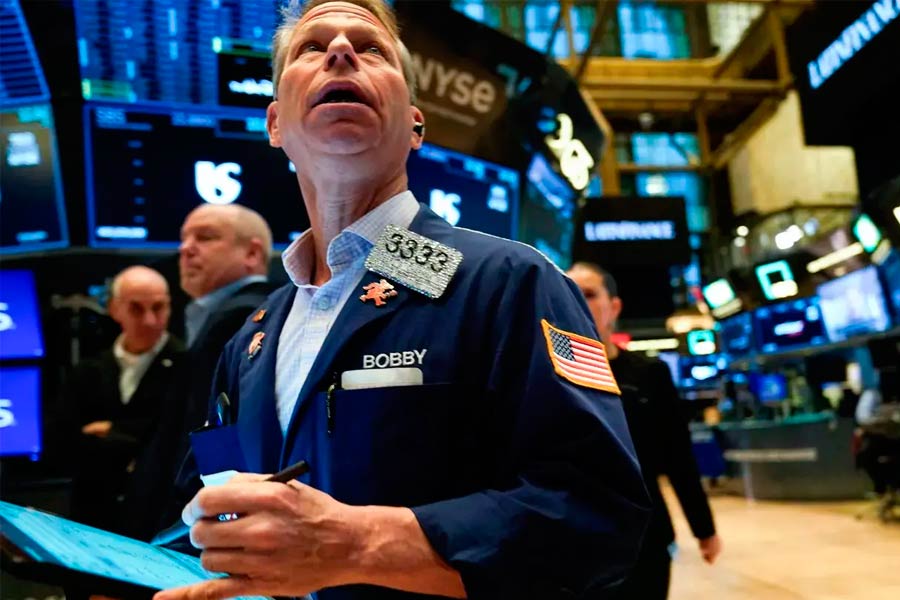
Profound shifts in the correlation of forces among the powers are behind this shake-up. China's rise openly challenges US leadership, a fact that is absolutely unquestioned by White House strategists who consider Beijing as a systemic threat to their hegemonic interests.
But China does not come alone. In the last ten years, and especially since the beginning of the war in Ukraine in 2022, there has been a leap in quality in the formation of an economic, military and diplomatic bloc led by China and Russia that attracts new allies and generates more complications for the West.
A powerful partnership which has confronted in the most diverse and far-reaching areas, displacing US influence in Asia, Africa, Latin America and Europe, and increasing global dependence on Chinese economic muscle. The West's retreat can also be seen in the military sphere. This is not a secondary aspect.
Imperialist distribution is carried out through unequal exchange between the more advanced nations with higher labour productivity and the less developed nations which cannot compete because of their low level of technology and development of their productive forces. But the use of force ultimately proves to be a crucial factor when agreements become impossible. War and militarism always accompany imperialist sharing. And the conflict in Ukraine, where the industrial, economic and technological strengths of each bloc involved, and the social support they have been able to mobilise, have been at stake, indicates the growing superiority of Moscow-Beijing.
Politics is concentrated economics, as Lenin used to repeat. It is impossible to think that these far-reaching changes in the material basis of society would not have a powerful impact on the political superstructure, on the traditional parties and on the relationships between the classes.
The rise of the extreme right in the USA, in Germany, in Austria, in France, in Italy, in Great Britain, in the Spanish state, in Argentina or in Chile is intertwined with these phenomena, as are the social and political polarisation and the violent oscillations in the psychology and mood of the masses. Of course, the political bankruptcy of the reformist left and its capitalist and militarist policies are very much responsible for the current scenario.
The economic factors we have described powerfully influence political developments, and vice versa. The relationship between the economic and political cycle feeds back dialectically. Establishing an insurmountable wall between these two factors has nothing to do with a Marxist approach. In the same way, the most significant social phenomena, just as in nature, do not present themselves in a pure state. There are all sorts of distortions, variations, singularities or particularities... but what is essential is to point out the underlying tendencies they are reflecting, and the objective causes that make them emerge.
Trotsky, in a great article titled Bonapartism and Fascism, pointed out that "the great practical importance of a correct theoretical orientation is most evident in epochs of acute social conflicts, of rapid political turns or of abrupt changes in the situation. In such times, political conceptions and generalisations are quickly superseded and require their total replacement, which is relatively easy, or their concretisation, precision or partial rectification, which is more difficult. It is precisely in these periods that all sorts of transitional, intermediate combinations and situations necessarily arise, which go beyond the usual patterns and demand continuous and redoubled theoretical attention. In a word, if in the peaceful and ‘organic’ epoch (before the war) it was still possible to live at the expense of a few preconceived abstractions, in our epoch every new event necessarily raises the most important law of dialectics: truth is always concrete"[1].
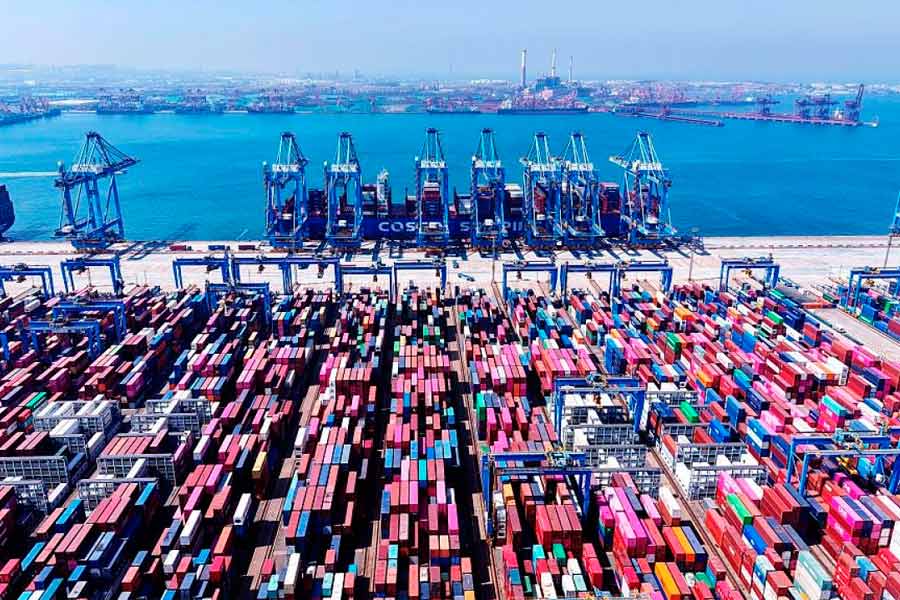
Globalisation and the development of China's productive forces
Since truth is always concrete, in order to understand Trump's new tariff offensive and its immediate consequences for the world economy and the class struggle, it is necessary to place it in the context we discussed earlier.
There are narrow-minded people who see history as a mere repetition of events, a succession of events that are reiterated with this or that superficial nuance. They claim that what is happening today shows the triumph of protectionism and the end of globalisation. Why think independently, and with the tools offered by Marxism, if certain economic press gives you everything chewed up with simple formulas?
To know history, to study it seriously and to understand the factors that triggered the great social and political transformations is an essential task, but it is not that simple. To take the template of a historical fact and a hundred years later place it on the present day and see if it fits or not, has very little to do with Marxism. It is not dialectics, it is vulgar mechanism.
By 1929 the world market was already an indisputable reality dominating national economies, brilliantly confirming the predictions of Marxism, i.e. the inherent tendency of productive forces to overcome the limits imposed by private property and national borders. The inter-imperialist struggle was developing intensely and ten years later, after an all-out tariff war, competitive devaluations and the collapse of production, it finally exploded violently in the Second World War. In this historical framework, there were also specific factors that must be taken into account when analysing the present time, as some of the differences were and are qualitative.
Firstly, there was the USSR, with its planned economy and as a factor that stimulated the international class struggle, even in spite of its Stalinist leadership. The fear of socialist revolution on the part of the possessing classes accelerated the fascist way out. Secondly, the globalisation and interconnectedness of economic relations, although very important, were still far from the degree of interdependence they are today.
It is important to note that, despite all the theories that are being put forward along the lines of claiming the triumph of deglobalisation and the division of the world economy into blocs, the data simply does not support such claims. Even after all the tariff measures and trade restrictions that have been passed in the last two years, it is entirely questionable to claim that we are going through a substantial reversal of globalisation. The Financial Times, in an article entitled The myth of deglobalisation masks real changes, admitted that ‘there seems to be no evidence of a shift towards deglobalisation’, and that the reality is ‘that the rest of the world economy is becoming less important to China, but the country remains increasingly important to the rest of the world economy’[2].
A substantial difference with respect to 1929 lies, among others, in these two relevant aspects. Globalisation has reached a qualitatively higher point in terms of the volume of international financial capital flows and the interdependence of global commodity production, supply and trade chains. A process that gained formidable momentum after the collapse of the USSR and the restoration of capitalism in China, and the consequent strengthening of the US imperialist order.
The issue that explains the virulence of the present struggle and the desperation shown by the Trump administration is not its rejection of globalisation, but the fact that the leadership of this globalisation no longer belongs to a single power - more precisely to the USA. In the last two decades China has become a productive giant that exerts a tangible hegemony in world trade. This is why the clash is taking on such brutal and difficult to reconcile contours.
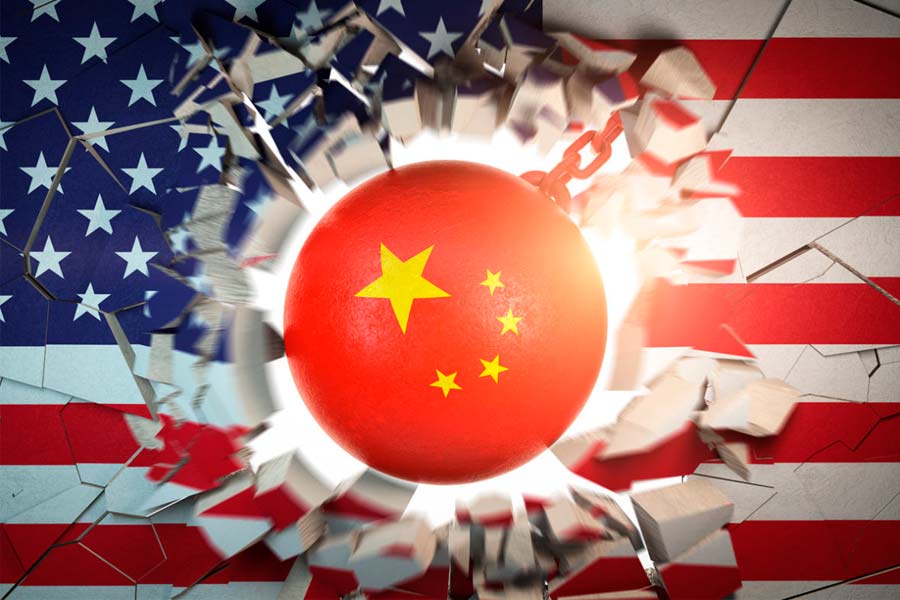
According to figures from 2023, China accounts for 28.7% of the world's industrial production volume. It is followed by the USA with 16.8%, Japan with 7.5% and Germany with 5.3%. During the five-year period 2020-2024, China's total GDP growth was 23.4%, that of the USA 15.0%, the EU achieved a meagre 12.2% and Japan 6.0%.
China accounts for 20% of global investment in research, development and innovation (R&D), and its universities graduate 1.5 million scientists and engineers each year, more than the United States, Japan and Germany combined. The World Intellectual Property Organization (WIPO) in its 2023 World Intellectual Property Indicators report reveals that in the previous year, 3,457,400 patent applications were filed worldwide, of which 46.84% were Chinese, compared to 17.2% from the US, and 8.4% from Japan.
A 2024 study entitled China is the world's only manufacturing superpower: an outline of its rise, highlights that ‘China's industrialisation is unprecedented. The last time the ‘king of manufacturing’ was dethroned was when the United States overtook the United Kingdom just before the First World War. It took almost a century for the US to reach the top; the shift between China and the US has taken about 15 to 20 years. In short, China's industrialisation defies comparison. [...] China started the race slightly ahead of Canada, Britain, France and Italy. It overtook Germany in 1998, Japan in 2005 and the United States in 2008. Since then, China has more than doubled its global share, while that of the United States has fallen by another three percentage points"[3].
While in major Western countries corporate profits have been channelled into speculative financial operations for decades and productive investment is declining, China's gross fixed capital formation (GFCF) has been rising steadily since 1995. In 2023, China's GFCF accounted for 41% of its GDP. In the same year, it was 21% in the USA, 21% in Germany, 23% in France and 18% in Great Britain. In Russia, in the midst of the war in Ukraine, it accounted for 22% (World Bank data) [4].
China's industrial superiority is increasingly overwhelming, and it has an ever-expanding automotive sector, especially electric vehicles. In 2022 it installed more industrial robots than the rest of the world, 290,000 compared to 263,000[5]. A study by the EU's Joint Research Center on ‘advanced factories’ (factories combining robotics, AI, 3D printing and dynamic data systems) underlines China's huge superiority: 20,000 compared to 7,500 in the US and 4,500 in Europe. The growth of these factories in China since 2009 has been 571%, compared to 130% in the EU and 75% in the US[6].
The data published by the Center for Economic Policy Research in January 2024 are clear: ‘The United States is much more dependent on Chinese manufacturing production than vice versa [...] China was more exposed to US inputs before 2002, but the United States has had greater exposure since then. In 2020, the United States was roughly three times more exposed to Chinese manufacturing output than vice versa [...] this shows a remarkable, historical and global asymmetry in supply chain dependence between China and other major manufacturing countries. Politicians may want to decouple their economies from China. However, these data suggest that such a decoupling would be difficult, slow, costly and damaging, especially for G7 manufacturers’[7].
Western propaganda insists on describing China as an export economy unable of generating a strong domestic market, a claim that is unfounded. The development of the productive forces in China has meant, as happened in Britain and the US, the formation of a growing middle class, and of broad sectors of the working class that have benefited from wage rises unknown in the rest of the world. In 2023, according to data from the National Bureau of Statistics, real wages in public enterprises grew by 5.5% and in the private sector by 4.5%, with increases of more than 13% in the financial sector or more than 11% in the mining sector, increasing real per capita income by an average of 6.3%[8].
Today China is not only the main exporting and creditor power on the planet, but is becoming a decisive market for the rest of the capitalist powers to sell their goods and services.
China's advance has only reinforced globalisation. The Lowy Institute, for example, points out that 128 countries trade more with China than with the US, and that the Asian giant has spent more than a trillion dollars on infrastructure in more than 140 countries![9] China has become a net exporter of capital to the world over the past decade, with its overseas investments reaching a record $162.7 billion in 2023.

The policy of Western sanctions against Russia has further exposed the advance of globalisation under Chinese rule. Not only have they been unable to isolate Putin, who has been backed at all times by China, but this retaliation package has become a boomerang against the US, accelerating the dollar crisis.
Trade between China and Russia has come to be conducted to a very high percentage in yuan, and other powers such as Saudi Arabia, a traditional US ally, signed a resounding agreement with China to buy part of its oil in yuan in exchange for the yuan being used to purchase Chinese products. Day after day, the list of countries (Brazil, Iran, Pakistan, Nigeria, Argentina, Turkey...) joining similar agreements grows[11].
These developments stem directly from earlier decisions
According to data from the economic portal Statista, ‘in 2024, China's economy accounted for more than 19% of the world's gross domestic product adjusted for purchasing power parity (PPP). With this value, China is once again the largest global economic power, surpassing even the United States, which came in second place with a share of 15.2%"[12].
For those who speak so lightly of deglobalisation, it must be said that world trade in 2024 registered an all-time record with exchanges amounting to 33 trillion dollars, driven by growth of 7% in services and 2% in goods, and all this taking into account that there were already significant protectionist measures by the US in addition to the sanctions imposed on Russia.
All this reveals China's export strength and its capacity to adapt. In 2022 - to cite the most complete data published so far - the gap with respect to its immediate competitors widened again: China exported $3.59 trillion worth of goods, compared with $2.06 trillion for the US, $1.65 trillion for Germany, $746.92 billion for Japan, $656.93 billion for Italy and $617.82 billion for France[13].
Therefore, the economic impasse in which the US finds itself has not been created in one year, nor in five, nor in two decades. This is a process that began in the mid-1990s, and which paradoxically was fuelled by the ‘political successes’ that US imperialism scored with the collapse of Stalinism, the demise of the USSR and the re-establishment of capitalism in Russia and China.
The incorporation of hundreds of millions of workers into the world market facilitated a new division of labour and colossal opportunities for Western capital to invest in these countries, obtaining returns unimaginable in the US and Europe. The fever of industrial offshoring that led to millions of redundancies gripped US and European capitalism, with consequences that are visible today. Offshoring showered the big multinationals with astronomical profits, which, far from investing them in the development of the productive forces of the USA, Great Britain or France, devoted themselves, in massive terms, to inflating the speculative bubble, inducing the absolute financialisation of the markets, acting in a parasitic way by buying up public debt by the bucketload and buying back their own shares to stimulate the rise in stock market values. The decay and parasitism of this model was exposed during the Great Recession of 2008, which shook the US financial system and the global economy. Since then, the process has become more acute and widespread.
China emerged fairly unhurt from the Great Recession, and later from the Pandemic, strengthening itself as a productive power, not as a colony supplying cheap labor and low-quality, low value-added products. The transfer of technology to China in these decades has been formidable because it was of interest to the Western multinationals that built gigantic plants in its territory, and because, and this is significant, the State capitalist regime and the CCP bureaucracy acted consciously by investing a gigantic mass of capital in the development of new means of production and transportation, in an unparalleled technological industry, in shipyards, steel and aluminum plants, in a vast network of pipelines, in the exploitation of rare earths, in the construction of new cities, in a sanitary network that gave the bell during the pandemic....
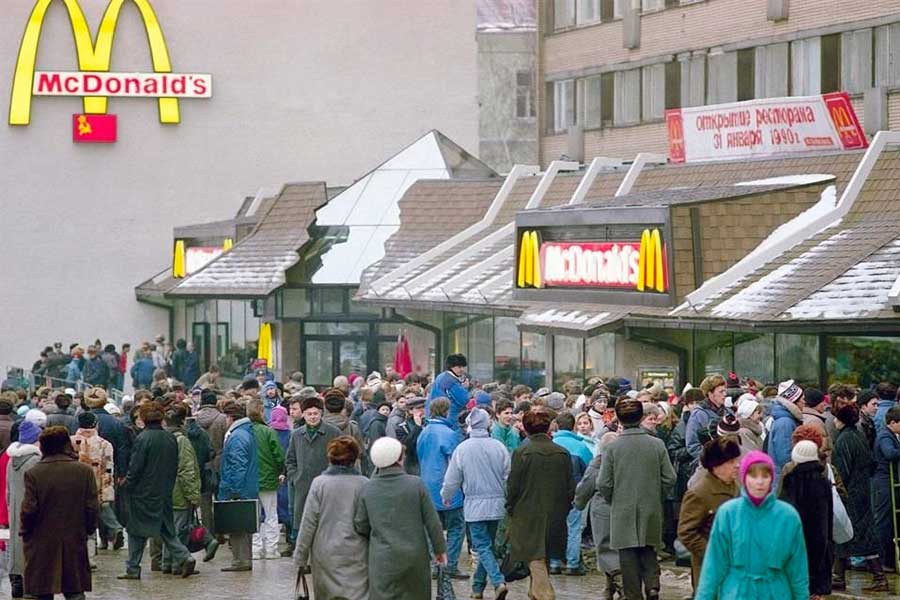
Its export power has allowed it to accumulate a stratospheric trade surplus with which it has flooded all continents with investments and, despite the obvious imbalances it drags along, such as a very high public debt, constant exposure to overproduction, and a ruthless exploitation of the labor force, without unions and independent organizations of the working class... it has shown that the singularity with which it faced the transition to capitalism grants it serious advantages over its major competitors. It is the contrast between a vigorous and rising capitalism and another in its senile phase.
The Chinese state capitalist regime is not the USSR, but the ex-Stalinist bureaucracy of the CCP learned a lot from the destructive chaos of the Yeltsin years. The direction of essential economic operations has been centrally designed. And the bureaucracy, as part of the new bourgeois ruling class that shares privileges and fortunes with many private sector billionaires, who also have the party card (it is mandatory)... it has been able to discipline at certain times the excesses and ambitions of some of its most prominent figures.
Obviously within the Chinese bourgeoisie there are divisions and contradictions that will surface when the difficulties escalate but, up to now, they maintain a quite important unity of criteria. All that has been said in no way implies sweetening the Chinese regime as a friendly imperialism, or a socialist market society as the left of Stalinist origin pretends.
China is an imperialist power with a lacerating inequality and great latent conflicts that have not yet been expressed to the extent that growth continues at a good pace. But the data are clear: of the 500 richest people in the world in the Bloomberg Billionaires Index, 81 are Chinese and accumulate a fortune of 1.1 trillion dollars. These figures are only surpassed by the United States, where 162 billionaires have a total wealth of 3.4 trillion dollars. According to another ranking, the Hurun Global Rich 2021, China has more than 1,000 billionaires, the most in the world.
As for another fundamental aspect: the Chinese domestic market is acquiring enormous dimensions and has become a key space for the main industrial firms of the USA and Europe, for their automotive, agriculture, food, mining, textile and luxury companies... Unlike the USA in its advance as an imperialist power, which first built a powerful domestic market to build its later foreign adventures, the historical process in China, thanks to the model of centralizing State capitalism, has been vertiginous and underlines the validity of the theory of unequal and combined development: China has burned through the stages very quickly, using Western investment to establish an efficient productive base, accumulate an impressive surplus, and at the same time build a gigantic domestic market that increasingly rivals the US market in terms of purchasing power.
The challenge faced by the U.S. ruling class is not small. Trump does not want to repeat what happened in his first term. In 2016, year one of his first presidency, the U.S. trade deficit amounted to $502.3 billion, and reached a deficit of $347 billion with China. In 2020, the year he lost the election, the U.S. trade deficit reached $678.74 billion, $310.8 billion with China.
Related to the European Union, the US deficit went from $151.575 billion in 2017 to $182.579 billion in 2020. With Joe Biden's presidency, it climbed to a record in 2024 of $235.571 billion.
Back to China. In 2024, the US imported $438.947 billion worth of goods from the Asian giant, and exported $143.546 billion worth of goods, with a resulting trade deficit of $295.402 billion. Although the deficit has been cut since 2016 by more than 50 billion, the figures are still too high and reveal the organic problem of dependence that the US economy has on China.
The experience of these eight years does not leave very good feelings.
Neither have industries returned to U.S. soil, nor have high-paying jobs multiplied, nor has the trade downturn been contained. In 2024, the overall U.S. trade balance recorded a deficit of $918.42 billion, 17% more than in 2023.
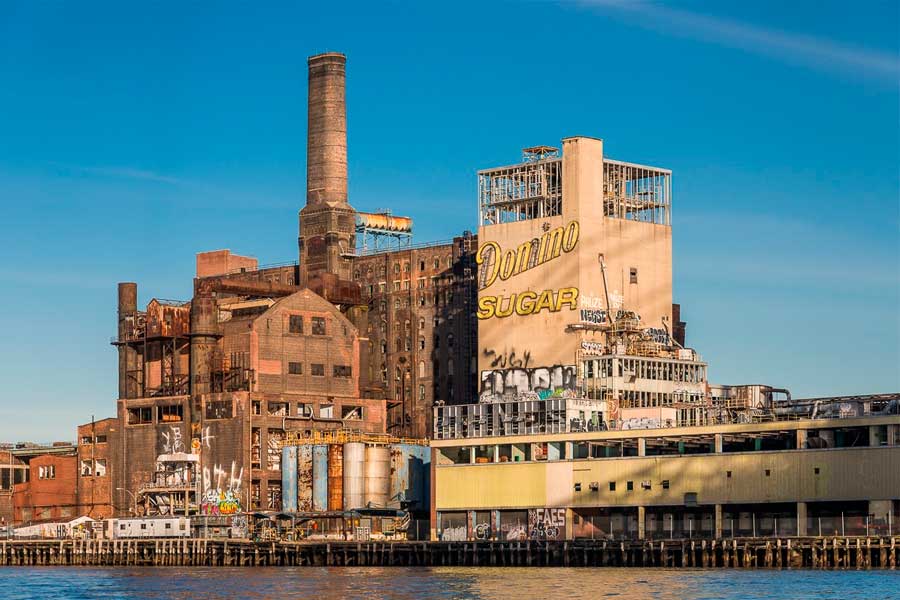
Trump's trade war and its multiple consequences
At the beginning of the 21st century, US trade dominance was undisputed. More than 75% of countries had Washington as their main trading partner versus a minority that had Beijing. By 2020 the position was reversed and China became, by far, the world's leading exporter. As a result, China accumulated gigantic foreign exchange reserves that in January 2024 amounted to more than $3.2 trillion.
And this is what explains the current dilemma in which the Trump Administration and the US bourgeoisie are struggling.
After months of threats, announcements, postponements and rectifications, Trump launched his plan on April the 2nd, bombasticly named “Liberation Day”. The decision ostensibly represents the biggest broadside against the multilateral system of trade and regulation of international finance that has been in place since the Bretton Woods Agreements of 1944. But this defiance, as the days have passed, has revealed what it is really about: bringing China to its knees with tariffs of 145%.
If the US government were to go through with its plans to the end, the consequences would be incalculable. A closure of American borders to Chinese products, and vice versa, the blockade of American capital and goods in China would have a devastating effect and would lead to a severe global recession. However, to think that this scenario is the only one, or the most likely one, is to consider too lightly the implications that all this would have for the Trump Administration, which, undoubtedly, is starting from a position of weakness and not a position of strength.
As we have described in this article, the global hegemony exercised by the US for eight decades is cracking at an increasing speed, and its ruling class is facing the prospect of beginning to lose exorbitant profits built up thanks to the role of the first US imperialist power.
It is quite clear that a good part of the US bourgeoisie does not share Trump's latest measures. This is witnessed by the harsh criticism of the heads of Goldman Sachs and J.P. Morgan, or the attacks that his measures have aroused in the big US business think-tanks[14] but, above all, the collapse of the US stock markets and the rise in interest to be paid on Treasury bonds, have finally forced Trump to postpone for 90 days the package of tariffs he intended to impose on the EU, his historical partners in the Western bloc. It was a first setback, but more have followed in a few days.
Trump may appear to be acting like a madman, but he is not. Everything he does points to the seriousness of the impasse the U.S. ruling class has reached. For the moment, the capitalists most critical of Trump are unable to define an alternative strategy to halt and reverse the decline of the US. And that vacuum is filled by Trump's demagogy, which is dragging behind it millions of medium and small investors, both entrepreneurs and middle class professionals, traders or rentiers of all kinds, who are used to make a lot of money in the highly speculative US financial markets (stock market, commodities, derivatives, public debt, etc.) and who see that their dreams of endless wealth are threatened by the unstoppable rise of Chinese capitalism.
It is this social sector that feeds the dream of an industrial revival of the US on the unlimited exercise of its imperialist power. Is not the US demonstrating with Netanyahu´s help that it can wipe the Palestinian population off the map with a savagery and inhumanity reminiscent of Nazism? Why not then apply this power to reestablish the golden years of Yankee capitalism?
Unfortunately for this sector, the material basis of American hegemony has disappeared, never to return. In 1945 the US was the great industrial power of the capitalist world, with Western Europe and Japan devastated by the war. That situation allowed Washington to turn the dollar into the world's currency of exchange and reserve. Thanks to this, the US drained wealth from the entire capitalist world, above all from the former colonial countries, to generously sustain its public finances and its immense fiscal deficit, and to propitiate an era of expansion for its private monopolies.
All this was possible and lasted so many decades because after the end of World War II world capitalism experienced unprecedented growth. American capital dominated the world, but the capitalists of other countries, especially in Western Europe, and also the working class of the advanced countries, received their share of the global wealth thanks to the policies of the social pact, which disarticulated the revolutionary upheavals in France, Italy and elsewhere. This share also increased thanks to American investments and innovation.
But all this came to an end in the mid-1990s when yields began to fall as a result of overproduction, and the neoliberal model was imposed to promote a new phase of capitalist accumulation, wiping out quality employment, decent wages and the welfare state.
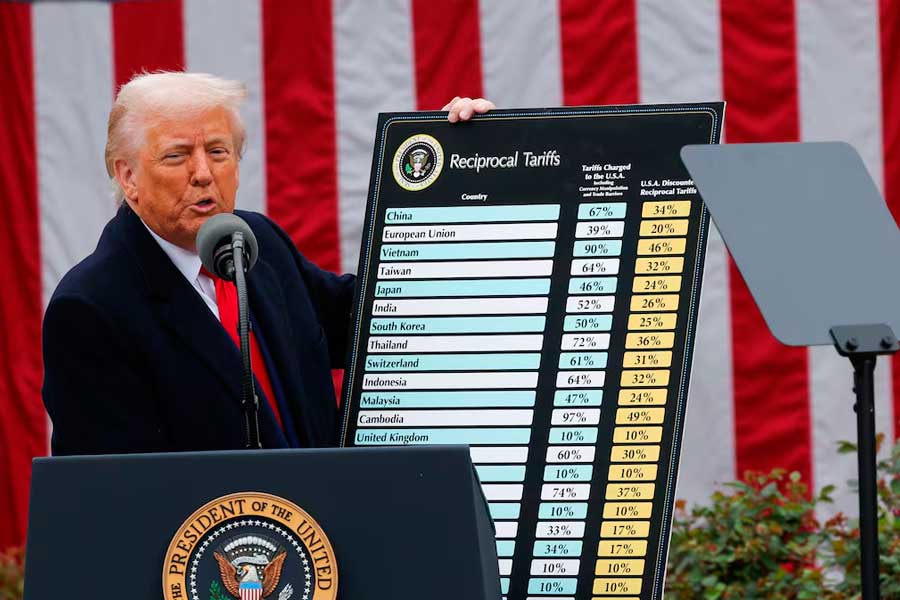
This dynamic was reinforced after the collapse of the USSR, opening the markets wide to financialization and the massive purchase of public debt. The Great Recession of 2008 revealed the limits of this “virtuous circle” of massive stock market profits, and revealed the crisis of overproduction that world capitalism was undergoing. Since then, the wealth of the US bourgeoisie has been derived to an even greater extent from financial speculation, at the cost of impoverishing its own working class and the rest of the world.
Financial speculation in the U.S. is rampant (see the cases of Tesla, Intel or Nvidia) and constantly threatens the productive bases of its economy. Labor productivity in the US has been growing at a declining rate for years,[15] a consequence of weak investment that adds real value to production.
But Trump and his supporters, including a significant part of the US technological and financial elite, believe they have discovered the recipe for dealing with this decline. If the global system of trade and finance that the US imposed after World War II has ended up creating the conditions for the expansion of Chinese state capitalism, it will simply have to be dynamited.
Falsifying the history of the last 80 years, Stephen Miran, chairman of Trump's Council of Economic Advisors, sets out in a recent document the strategy to be followed[16]. According to his vision it has been the US, with its strong dollar policy, who has been generously paying for the industrial development of the rest of the world. According to this logic, when the US printed dollars without any real counterpart and exported its inflation, it turned out that it was doing us a great favor and that the rest of the world was living by parasitizing the wealth created by US companies.
The consequence is clear and Trump puts it bluntly: the whole world has been stealing from the US and it's time for them to start giving back.
More tariffs to industrialize the US?
Trump's tariffs, even if they have been postponed for 90 days with the exception of those affecting China, are intended to create maximum tension and plunge the companies and countries most dependent on the export of their products to the US into extreme circumstances. Kenya, Madagascar, Ivory Coast, Cambodia, Vietnam and even Indonesia could soon find themselves facing the closure of factories and the ruin of tens of thousands of farms if they do not accept draconian negotiating conditions. Affected governments and companies would have to offer, at least initially, compensation to the US so that their tariffs would be mitigated.
Trump has the experience of the heavy tariffs imposed on the EU in his first term. After three months of closed-door negotiations, the then President of the European Commission, Jean Claude Juncker, managed to cancel them in exchange for significantly increasing purchases of gas, soybeans and armaments from the US and postponing for several years the regulations on polluting emissions from motor vehicles, which particularly affected American cars.
But circumstances have changed a lot. As we saw on the occasion of the sanctions on Russia, a large part of the world's countries no longer kneel down compliantly to US impositions. Therefore it seems inevitable that over the coming months we will begin to see a solid strengthening of China's economic and trade ties with all the countries trampled on by Trump.
It is important to note it is impossible for world trade to do without the gigantic volume of US purchases in the near future. With annual imports of nearly $3 trillion, the US is by far the world's largest importer. But this fact creates a mutual dependency. While it is difficult for exporting countries to find an alternative market to the US in the short and medium term, it is also true that US industry lacks the capacity to replace imports with its own production.
The best proof of these important limitations is Trump's decision, on April the 11th, to totally exempt from tariffs cell phones, computers, chips, hard disks and other electronic components, as well as the machinery needed to manufacture semiconductors, even if they come from China. The interests of large American corporations, such as Apple, Intel, Dell and many others, have finally prevailed, and Trump has been forced to take a step back in the face of the danger of ruining his most important companies.
It is likely that in the coming weeks or months these exemptions will be extended as the difficulties of American industry are confirmed. Replacing with domestic production such an extraordinary volume of imported goods, which are essential for their manufacturing chains, is not a task that can be done with a click on a button.

How will this impasse be broken? Trump hopes to do so by forcing foreign companies to lower their costs, and by breaking the internal unity of blocs like the European Union. That is why he supports a global far-right movement that will take control of key governments, which it can condition and manage with no strings attached, and in the process create the political conditions best suited to successfully confront the radicalization of the class struggle with totalitarian and police measures. But this, it must be remembered, does not solve the immediate problems.
The pretension of turning the U.S. into a first-rate industrial machine is all very well written on paper, but make it a real is much more complicated. Making America Great again means completely overturning the current U.S. industrial system, and making gigantic investments in capital and technology that would erode the quick, multi-billion dollar profits offered by the Wall Street casino economy. Ensuring attractive returns for productive investment is not so easy, barring a policy of massive state funding, so to speak, a return to a Trumpist variant of state Keynesianism. But this does not appear to be the president's plan.
Tariffs of this size on Chinese goods theoretically give U.S. industry a quantitative advantage. But that is theory. Realizing that potential requires political and business will and massive investment in upgrading and improving U.S. plants to make them more competitive and emancipate them from Chinese supplies. If this is not done, and it will take a long time to implement, these tariffs will lead to an enormous increase in production costs and an inflationary spiral, which will inevitably combine with a depressed market. The phenomenon of stagflation may spread and also provoke an earthquake of social mobilizations against Trumpism.
In other words, the advantages of flooding the North American market with products made in the USA are not so automatic either. There is a big question mark on this aspect.
The attempt to compensate the difficulties encountered by relying on the devaluation of the dollar to sell more on the world market will come up against the retaliatory measures of Xi Jinping's government, which has already responded with tariffs on US products of over 120%, and also against the possible reaction of the EU, which, due to the 90-day truce, is not clear yet.
Domestic repercussions for the US
As we have already explained in previous materials[17], Trump's new tariffs will immediately imply that US consumers will pay higher prices for imported goods, and US companies that need to buy abroad raw materials or components for their operation will see their costs significantly increased and will lose competitiveness in world markets.
These negative consequences will be multiplied by the effects of the countermeasures that countries around the world will adopt against U.S. products, and they will not be limited to tariff increases. China, for example, in addition to increasing tariffs in the same proportion as the US, will adopt additional measures such as a ban on exports to the US market of strategic materials for its industry.
Trump's attack has been of such a size that the Federal Reserve itself warns that the US and the rest of the world could plunge into a new recession. And from the ranks of Trumpism, voices have already emerged, led by Elon Musk and several Republican senators, calling for an end to the trade war, at least with the European Union.
Undoubtedly, the massive demonstrations on April the 5th against Trump in more than 1,100 US cities have also been an important factor in this abrupt change of opinion. The American working class is not willing to bear the cost of trade war policies aimed solely at protecting the immense profits of American billionaires. Much less so when Trump has just approved a tax cut that will save those billionaires $4.5 trillion in taxes over 10 years.
There is nothing anti-establishment about this plutocrat's agenda. His populist demagoguery hides an aggressive policy to plunder public finances, and to implement deep cuts in the already meager social benefits received by the most impoverished sector of the American working class.
Sectors of the U.S. ruling class understand that it is premature to provoke a social explosion of incalculable consequences for the precarious internal equilibrium of U.S. capitalism. Despite Trump's attempts to sow the seeds of racism and hatred of immigrants among the popular sectors, the unity of the working class reinforced by the struggles of immigrants since 2006, by the struggle of Occupy Wall Street and Black Lives Matter, by the mass mobilizations of women, by the struggle of the most precarious workers for a $15 an hour wage and for the recognition of their unions and, even in spite of the shameful capitulation of its leader to the Democratic Party apparatus, by the movement led by Bernie Sanders, is remarkable and has not been swept away by the divisive maneuvers of Trumpism.

U.S. debt, the Sword of Damocles
Although Trump is very careful not to talk about it, the main and most immediate risk for the US economy is not the trade deficit but the disproportionate size of its debt, both that of the public sector and that of private companies.
The US fiscal deficit has already reached 6% of GDP and its debt, at almost 35 trillion dollars, represents 121% of this indicator. By the end of this year, interest payments on this debt will become the main item of US public expenditure, well above its military budget.
A report by the Council of Foreign Relations in 2023[18] pointed out that, even by reducing its growth rate, the US public debt will double in 30 years, making interest payments extremely difficult, not to mention the burden that these payments will place on productive investment.
What will happen to this huge debt if the trade war triggers a recession or simply a slowdown in economic growth? Well, interest rates on 10-year bonds are likely to soar even higher, and sales by global holders are likely to accelerate. In other words, the US will have to disburse more capital to finance itself, because there are doubts, many doubts, about the evolution of its economy.
But far from being alarmed, Trump's economic strategists have already designed a masterful way out of this problem. Stephen Miran's paper cited above outlines a radical “solution” to the unbearable cost of debt. Since the debt has been generated by generous US contributions to the rest of the world, it is now up to the rest of the world to bear the costs. How? By converting the debt in the hands of foreign holders into low-cost perpetual debt or by transforming it into very long-term debt (100 years) at a ridiculously low interest rate. This is the equivalent of a debt write-off that foreign investors would have to accept willingly or by force.
For the moment, these plans have not gone beyond paper but if they were made true, such an exit would imply much more than a trade war.
Whatever happens in the first skirmishes of this trade war, it seems that Trump has not well calculated the impacts that his trade measures will have on the valuation of the dollar and its role as a reserve currency and as a decisive currency in international financial and commercial transactions.
Trumpist strategists are betting on the permanent depreciation of the dollar as a measure to facilitate the long-desired US reindustrialization. A cheaper dollar would favor exports and the progressive return to the US of American investments abroad. But competitive currency devaluation is also something that its competitors can do, and the Chinese government is well aware of that. All this was played out after the crash of 1929, and the results were pretty unfortunate.
Leaving aside the radical impossibility of transferring to the US the production that for several decades has been delocalized to countries with lower wage costs, a depreciation of the dollar can only further aggravate the inflationary effects of the new tariffs and thus fuel the widespread social discontent that already exists in the US.
Whatever monetary tricks Trump and his strategists come up with, no such maneuver can solve the basic problem of American capitalism. No matter how much dominance the dollar still maintains in world financial markets, no matter how much capacity the Fed retains to operate with interest rates, nothing can change an indisputable fact: the gap between the average productivity of Chinese workers and that of American workers is shrinking at an ever-increasing rate.

Trump's measures may create and spread chaos, they may generate immense short-term benefits for the US financial oligarchy, but the decline of capitalism in that country, far from being cushioned, risks deepening at an unforeseen speed.
In the coming weeks, the most immediate consequences of the trade war that Trump has unleashed will begin to be seen. We will be able to know, in real time, if US imperialism has enough reserves to face the earthquake it has unleashed, or if this war will lead to a new defeat and a new step backwards - and this time a giant step backwards - for Washington's world order.
Footnotes:
[2] El mito de la desglobalización oculta los cambios reales
[3] China is the world’s sole manufacturing superpower: A line sketch of the rise
[5] China, el país que más robots industriales instaló en 2022
[6] Advanced manufacturing industry is growing significantly in the EU
[7] China is the world’s sole manufacturing superpower: A line sketch of the rise
[8] Ingreso disponible per cápita de China crece 6,3% en 2023
[9] China, EEUU y la lucha mundial por el poder y la influencia
[10] El plan de China para salvar los aranceles de Occidente: sembrar el mundo de fábricas
[11] Desdolarización: cómo Occidente impulsa al yuan chino
[14] Trump’s Tariffs Are a Historic Tax Hike
[15] U.S. Bureau of Labor Statistics
[16] A User’s Guide to Restructuring the Global Trading System




















































